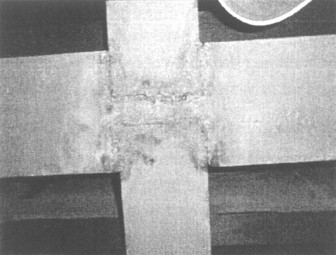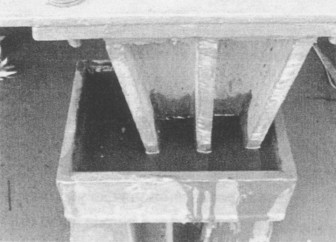Engineers who probed the failure of the docking system at the Supenaam Stelling in 2010 flayed both the supervisor VIKAB Engineering and BK International and their findings raised concerns about the integrity of the design and unauthorized changes leading to wasteful expenditure.
Although nearly two years old, the report was only tabled in the opposition-controlled Parliament on Thursday in response to a question by AFC MP Khemraj Ramjattan. The government had previously steadfastly refused to release the report.

Neither VIKAB nor BK have spoken publicly on the matter following the submission of the report in June, 2010.
The report said that BK International as well as the two consulting firms associated with the construction of the bungled stelling on the Essequibo Coast, all contributed to the failure of the $450M project which failed after it was unveiled for public use last year.
The report was done by Bert Carter and Marcel Gaskin who were appointed by the government following tit-for-tat exchanges among the contractor, the Local Government Ministry as well as the Ministry of Public Works as regards which party should have taken responsibility for the gross failure of the project. There were also major design flaws as well as the unaccounted substitution of materials for the construction of aspects of the works.
According to the report, “the quality of the work done as well as the workmanship associated with the contractor, BK International, reflects very poorly on the supervising capacity of VIKAB Engineering”. It was noted too that the shortcoming did not exonerate BK International from aspects of the poor quality work done. VIKAB Engineering in collaboration with Canadian firm SNC Lavalin International designed the project. Both VIKAB and SNC Lavalin have had longstanding association with projects here. SNC Lavalin however later dropped out of the project for cost reasons though the engineers could find no documents substantiating this.
“There seems to be no sense of pride associated with the “final product”, the two engineers noted in their report.
In relation to the link bridge ramp and pontoon, the engineers stated that both consultants associated would be “hard pressed to admit that they had any previous experience in the field. If they can confidently claim any knowledge, either by experience or association, then the mistakes made would have to be accounted for by gross negligence”, they said.
Tender documents
According to the report, a review of the tender documents, namely the illustrated designs for the project displayed a stelling to which a ramp with an attached concrete surface was to be built. The two engineers analyzed the construction of a pontoon to which a ramp was expected to be positioned and stated that the latter infrastructure later sank while works were being undertaken.

The team noted that based on discussions with BK International, it was pointed out that the original design for the pontoon did not consider the installation of bulk walls and according to the report, “this deficiency was pointed put out to the consultant”. However, the firm did not find favour with its implementation. Later, after the pontoon had sunk and was salvaged, attention was given to the installation of some partial bulkwalls. It was noted by the engineers that a major modification was carried out on the pontoon after it sank and was retrieved. “Its retrieval as well as the plate work added unnecessary costs still without achieving the design objective” the team noted.
As regards the steel gangway at the facility, the engineers stated that additional plates were expected to be placed on either side of the structure as indicated in the design plan. However, this was not done while works were on-going and later led to the end beam which had failed when the facility was unveiled last year buckling under the weight of vehicles at the time. No documentation was found to provide an explanation as to why the additional plates were not installed, they noted.
Drawbridge
The report noted too that the attachment of a drawbridge, which was placed at the facility after it was handed over to the authorities by BK International, was not in keeping with the intent of the design. They recommended that the gangway be modified so that the ferry can dock safely without the use of the drawbridge projecting from the stelling. “This is not a desirable option since it is unsafe. This type of drawbridge has to be lowered into an area where there are parked cars and passengers waiting to disembark.”
It was noted that the intent of attaching the drawbridge was in response to the problems of the vessels being moored too far from the conventional timber gang planks used at the stelling. It was noted by the engineers that it was only after the failure of the of the support beam for the drawbridge occurred that the authorities voiced concerns about the integrity of the beam. “The impression is that they were operating under some sort of administrative pressure to get the facility functioning”, the engineers stated.
The team stated that it was concerned that non-standard connection details were used by BK for the welding of aspects of the facility. It stated that this occurred throughout the structure as well as on the hinged support between the pontoon and the gangway. This, the report stated, allows water to be collected at the pivot points and could lead to corrosion of the metal connection.
The engineers noted that the ramp and pontoon structure installed at the Moleson Creek ferry crossing on the Corentyne “is a good guide as to what a typical loading facility should look like, regardless of the methodology”, whether for side loading or for a roll-on/roll-off service.
Since its construction, the Supenaam stelling was found to be inoperable and public fears that those responsible for bungling the $450M project would escape culpability seemed to ring true when former President Bharrat Jagdeo announced in May last year that taxpayers would have to foot the bill for remedial works.
Gaskin and Carter in their report were however of the view that for the unapproved and poor works there should be some recovery for the client, the Guyana Government.
They stated: “The Client should write VIKAB Engineering Consultants asking them to confirm, or otherwise, that all the design details issued in the Tender Document Drawings along with all the changes reflected in the `as built’ drawings were done by them. If not by them, they should be made to say by whom. The stated party should then be written asking for reasons and corresponding explanations as to the design shortcomings and why the offended party, the Client in this case, should not be compensated. The report cited several major tasks undertaken by the contractor and added that “these additional costs appear to have only added to what appears to have been an already overpriced job”.
It is unclear if President Jagdeo or the government sought to recoup any money from those engaged in the project.
Jagdeo had ordered an investigation into the project following charges by BK International, that modifications done by the Ministry of Works led to it becoming inoperable. The ministry had denied this, saying that it was the Transport and Harbours Department (T&HD) that took over a facility “which was inadequate to handle the typical flotation as well as the arrangement to get on to the vessel for the heavy truck traffic from the Essequibo.”
Minister of Transport Robeson Benn had said that his ministry had spent an additional $17.2 million on modifications, including the drawbridge and a pontoon, both of which he considered “absolutely necessary.”
Benn had said that the Ministry of Local Government supervised the construction of the stelling and later issued a certificate of completion to BK International even though the completed project had obvious defects. The drawbridge was also a major source of contention between BK and the Works Ministry, with BK saying that it should not have been attached to the loading ramp and Benn saying that the installation of the 1.7-tonne steel drawbridge was to guarantee the safe offloading and reloading of vehicles, particularly trucks, this newspaper reported.
The stelling is operational at the moment but not to its full capacity since only 16 tonnes per truck is allowed to use the facility.
The engineers report also alighted on a key personnel change which raised eyebrows. While they were conducting their inquiry in May, 2010, the engineers met with Brian Tiwarie of BK and during the course of that meeting he was joined by Julian Archer. Archer had previously worked on the project as the Supervising Site Engineer before resigning in July, 2008 and proceeding to BK. However, the engineers noted that a VIKAB drawing dated March 2009 was “mysteriously checked by J. Archer” who had resigned the year before.
The government later awarded another contract to BK International to modify the facility in order to facilitate the two roll-on-roll-off ferries from China. Works are said to moving at snail’s pace while the two ferries sit along the Georgetown Ferry Stelling.
Appendices
The appendices to the report revealed interesting tidbits. As public pressure grew over the bungled project, Prime Minister Hinds wrote President Jagdeo on May 12 in which he summarized some of the issues.
He related that no record had been found of the design brief provided to the consultant and the design was inadequate for a loaded truck of 22.5 tons “both in overall design and in the details”. He added that the contractor BK may have built to design but Minister Benn pointed to poor workmanship which could further compromise an already poor design.
He signed off on his letter simple as “Comrade Sam”.
In his summary of events, Minister Benn noted the project had been over the delivery date by 439 days. He related how the Guyana Times of January 20th 2010 “surprisingly and erroneously reported that the test (of the stelling) was a success in headlines which contradicted Minister Benn being quoted in the accompanying article as saying that two major difficulties had to be addressed relating to the ramp and the pontoon”.
Timeline
*Project set to start March 14, 2006 and end September 14, 2007
*Project goes over deadline by 439 days
*February 13, 2009 – composite concrete and steel pontoon sinks. Design changes made
*December 1, 2009 – Local Government Ministry makes handing over visit with Ministry of Public Works and flaws pointed out by latter
*December 10, 2009 – T&HD presents report and proposes construction of controversial drawbridge
*January 19, 2010 – Test of offloading from MV Torani fails. Flotation and a gap between ramp and vessel seen as problems
*April 27, 2010 – As new pontoon and drawbridge were being installed as remedy, pontoon breaks loose and sinks
*May 8th, 2010 – Pontoon recovered and facility put in use
*May 11, 2010 – Beam supporting drawbridge buckles
Operations suspended
*May 12, 2010 – Meeting held with President and enquiry planned
*June 2010 – Report of engineers submitted




